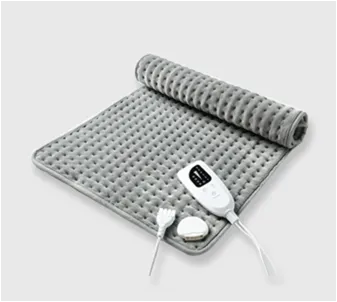
Авг . 13, 2024 13:24 Back to list
Exploring the Energy Efficiency of Heated Blankets for Comfortable and Sustainable Winter Warmth
The Energy Efficiency of Heated Blankets
As the chilly months approach, many individuals seek comfort in heated blankets. While these cozy items provide warmth and relaxation, an often-overlooked aspect is their energy efficiency. Heated blankets can be a great way to conserve energy while still enjoying a soothing, warm environment. In this article, we will explore how heated blankets operate, their energy-saving benefits, and tips for using them effectively.
How Heated Blankets Work
Heated blankets are designed with electric heating elements woven into the fabric. These elements generate warmth when connected to a power source. Most modern heated blankets come with adjustable heat settings, allowing users to customize their temperature preferences. This feature not only enhances comfort but also contributes to energy efficiency by permitting users to select a lower setting when higher temperatures are unnecessary.
Energy-Saving Benefits
One of the most significant advantages of heated blankets is their ability to provide direct warmth to the user, promoting energy savings in the home. Instead of heating an entire room or relying solely on central heating systems, individuals can warm themselves using a heated blanket, which requires significantly less electricity than traditional heating methods.
For example, a typical electric blanket uses between 60 to 100 watts of power. In comparison, an electric heater can consume up to 1500 watts. By choosing to use a heated blanket instead of cranking up the thermostat, households can reduce their overall energy consumption, leading to lower utility bills and a reduced carbon footprint.
Optimal Usage Tips
heated blanket energy efficient

To maximize the energy efficiency of heated blankets, there are several strategies that users can implement
1. Preheat and Retreat Before bedtime, users can preheat the blanket for a short period, creating a warm environment to ease into sleep. Once comfortable, the blanket can be switched off or set to a lower temperature to maintain warmth without wasting energy.
2. Layering Heated blankets can be used in combination with regular bedding. By layering a heated blanket on top of conventional blankets, users can retain warmth more efficiently, reducing the need for excessive heating.
3. Set a Timer Many modern heated blankets come equipped with timers. Using this feature ensures that the blanket turns off after a certain period, preventing unnecessary energy usage while the user sleeps.
4. Choose Programmable Models Investing in a programmable heated blanket can help manage energy consumption effectively. Users can set specific heating schedules to align with their routines, ensuring comfort without the risk of leaving the blanket running for extended periods.
5. Regular Maintenance Keeping the blanket in good condition ensures that it runs at peak efficiency. Regular inspections for wear and tear, and following the manufacturer's care instructions, can prolong its lifespan and maintain its energy efficiency.
Conclusion
Heated blankets represent a practical solution for those looking to stay warm while being mindful of energy consumption. They offer an effective means of personal heating, allowing individuals to cut down on overall electricity use while still enjoying a comfortable living environment. By understanding how to use these blankets optimally, consumers can enhance their comfort and contribute to energy conservation efforts. As we navigate colder seasons, embracing heated blankets can be an excellent choice for warmth without compromising on energy efficiency.
-
Warm Comfort with Heated Mattress Solutions
Mar.27,2025
-
The Power of Heating Pads for Comfort
Mar.27,2025
-
Stay Warm and Comfortable with Targeted Heat Relief
Mar.27,2025
-
Maximize Your Comfort with Heated Bedding
Mar.27,2025
-
Heat Relief for Every Need
Mar.27,2025
-
Embrace Comfort with Heated Pads
Mar.27,2025
Realted Products



